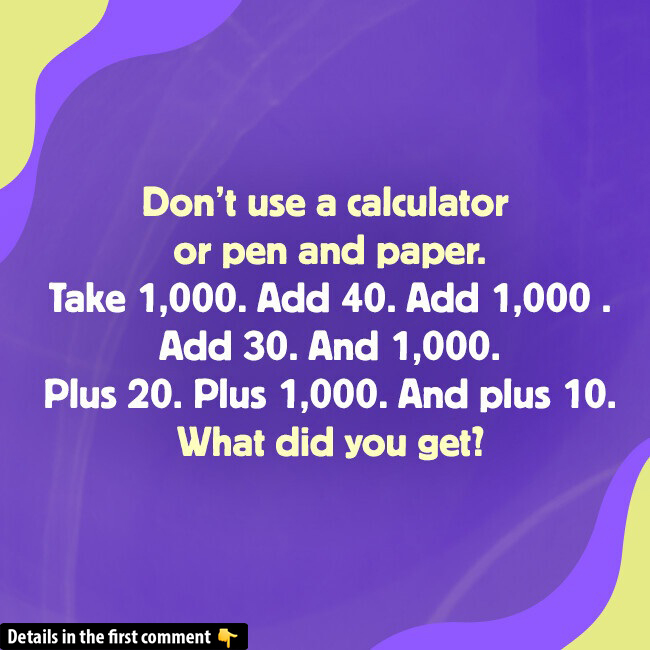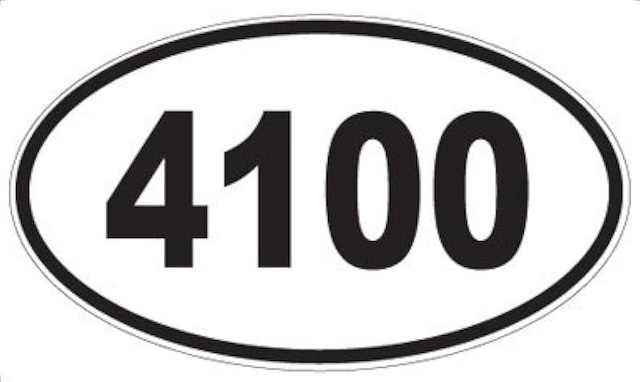Alright, math lovers—here’s a challenge that’s more about focus than formulas. No pen. No paper. Definitely no calculator. It’s just you, your brain, and a sneaky little puzzle that tests whether you can keep your cool while crunching numbers in your head.
This isn’t some advanced algebra problem. It’s simple addition. But as with all great puzzles, it’s the details that trip people up. Ready to prove you’ve got the mental edge? Let’s dive in.

The Challenge: A Pure Mental Math Test
Here’s the sequence you need to solve:
Start with 1,000,
Add 40,
Add 1,000,
Add 30,
Add 1,000,
Add 20,
Add 1,000,
Add 10.
Sounds easy, right? You might already be racing through it in your head. But pause—because this puzzle is notorious for tricking people into making a classic mental math mistake.
Video: Find a spark of joy in your day with these playful mental teasers!
Why Most People Get This Wrong
Let’s be honest: mental math is as much about rhythm as it is about accuracy. We like to move quickly, and sometimes our brain gets ahead of itself. Here’s where the missteps usually happen:
- Rushing through the steps: People often skip over small numbers or group things incorrectly.
- Misjudging when the totals cross a new thousand: That leap from 1,000 to 2,040 to 3,070? It’s easy to miscalculate when you’re not writing it down.
- Assuming the answer without checking: We tend to trust our first gut answer. But when you slow down and add carefully, the outcome might surprise you.
So, what’s the real answer? Let’s break it down, one step at a time.
Step-by-Step Mental Walkthrough (No Paper, Just Brain Power)
Here’s how to keep it straight while solving in your head:
- Start with 1,000
- Add 40 → You’re at 1,040
- Add 1,000 → That’s 2,040
- Add 30 → Now you’re at 2,070
- Add 1,000 → That brings you to 3,070
- Add 20 → You’re at 3,090
- Add 1,000 → Hello, 4,090
- Add 10 → Final total: 4,100
Final Answer: 4,100

If you said 5,000, don’t worry—you’re not alone. It’s one of the most common incorrect answers. Why? Because the brain often rounds and stacks numbers mentally without double-checking.
This kind of puzzle is a subtle test of attention, sequencing, and patience. All the math is basic—it’s how you process it that counts.
What Makes This Puzzle So Effective
You’re not solving for X or decoding symbols here. This challenge works because it uses something we all think we’ve mastered: basic addition.
But it’s how we mentally organize that addition where things fall apart. It’s like trying to juggle eight balls when you’re used to three. Unless you stay present, one’s gonna drop.
And that’s the beauty of it: even the simplest tasks demand focus.
Mental Math: A Muscle Worth Training
Here’s the truth—mental math isn’t just useful for solving puzzles. It’s a skill that boosts:
- Cognitive agility
- Short-term memory
- Concentration
- Decision-making speed
Think about it. Whether you’re splitting a check, estimating a discount, or budgeting your weekly groceries, quick mental math keeps you sharp and saves you time.
And let’s be real—there’s something satisfying about solving a problem in your head without reaching for your phone.
Tips for Improving Your Mental Math Game
Video: ONLY A GENIUS CAN SOLVE THESE RIDDLES 🧩 | 20 TRICKY RIDDLES THAT’LL STRETCH YOUR BRAIN 🧠
If this puzzle gave you a mental workout (or a mental wipeout), don’t sweat it. Here are a few simple ways to get better:
- Chunk numbers: Break them into parts that are easier to handle. Instead of 1,000 + 40 + 1,000, think: (1,000 + 1,000) + 40.
- Use round numbers: Temporarily round numbers to the nearest ten or hundred to estimate quickly—just don’t forget to correct them afterward.
- Practice daily: Do one small math challenge a day. Seriously, even 3 minutes helps.
- Engage with puzzles: Riddles, brain teasers, and even number games keep your brain in motion.
Think of it like going to the gym—only it’s your brain doing the heavy lifting.
Why Sharing Your Strategy Matters
One of the coolest things about puzzles like this is that everyone solves it a little differently. Some people count up slowly, others skip ahead and correct. Some visualize a number line in their head, while others hear the numbers spoken aloud in their brain.
So don’t just keep your solution to yourself. Share how you got there. Someone else might learn a trick from your method—and next time, they might help you in return.
Conclusion: Mental Math Isn’t About Speed—It’s About Precision
This puzzle looks simple, but it teaches a powerful lesson: thinking clearly beats rushing fast. In a world where everything’s automated and app-powered, relying on your own mind feels like a superpower.
If you nailed it, awesome—flex that mental muscle. If not, that’s okay too. Every puzzle you attempt makes you sharper than the last.
And next time someone says, “It’s just adding numbers,” you’ll smile—because you know there’s way more to it than that.


